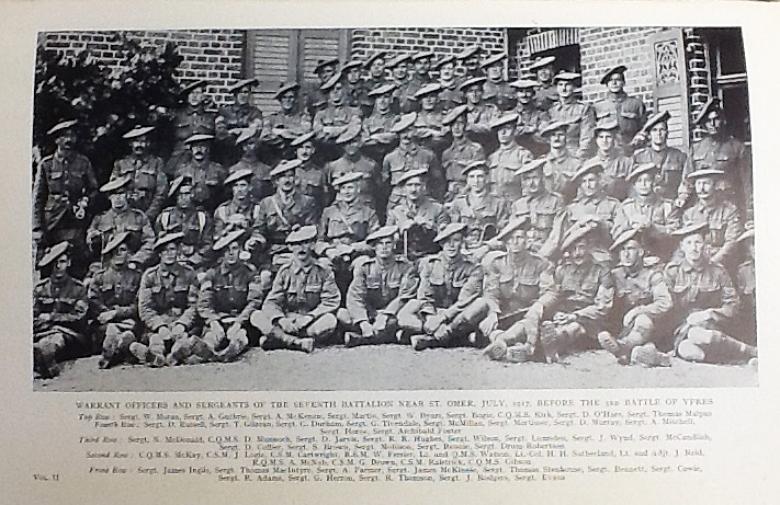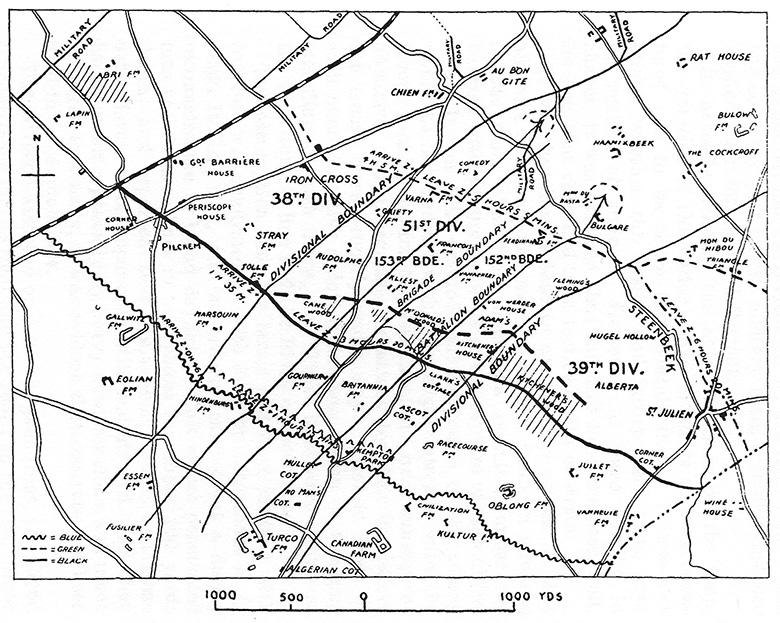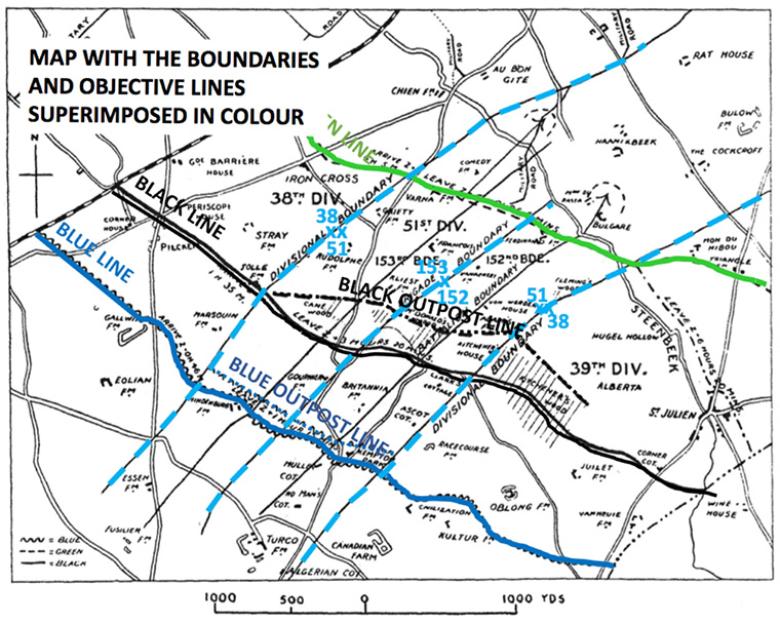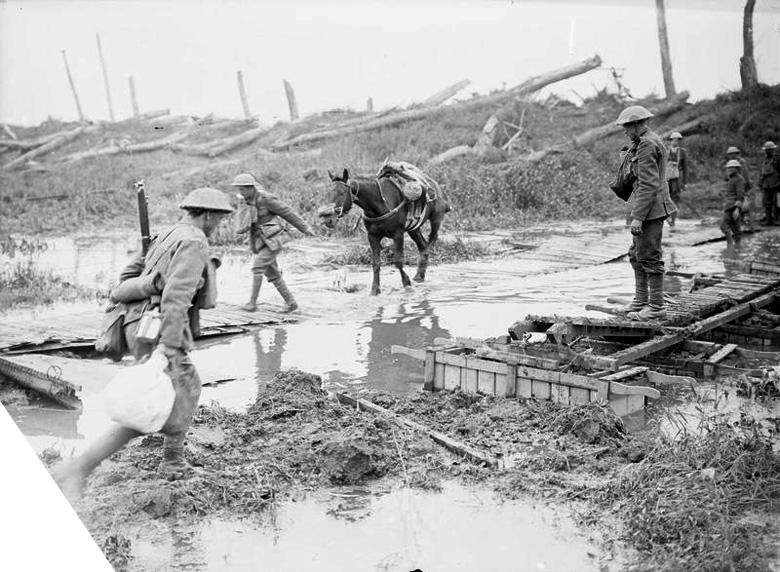The 3rd Ypres / Passchendaele
Jul - Nov 1917
This account is a precis from 'The History of the 51st Highland Division 1914-1918' by Major F W Bewsher D.S.O., M.C. with links to extracts from regimental histories.

BW Officers Before 3rd Ypres
show infoDescription:
Warrant Offices and Sergeants of 7th Black Watch near St. Omer, July 1917, before the 3rd Battle of Ypres
Tags:
On 12th June, 1917, the 51st Highland Division was transferred to the XVIIlth Corps, and on the 15th General Harper was informed by the Corps commander, General Sir F. 1. Maxse, that the Division would shortly occupy a portion of the Ypres salient, from which it would take part in a great attack. Previously, on the 7th June the Messines-Wytschaete Ridge which overlooked the salient had been captured. Beyond it the Passchendaele Ridge remained as the next objective.
The Divisional sector would be due north of Ypres. Despite the capture of the Messines ridge the position was still under artillery fire and the defenses needed improvement. About 2000 yards behind the front line ran the Canal de I'Yser.
Only the front line of the enemy position on the crest of a small rise known as the High Command Redoubt could be seen. This overlooked the whole of the British trench system as far as the canal bank. The only other feature in the enemy's lines which could be observed were the tops of the trees of Kitchener's Wood.
The attack was not delivered until 31st July, so that the Division had six weeks to prepare:
The poor position had to be transformed into a jumping-off place for the attack.
The troops had to be trained to attack a position that they could not see.
The artillery had to cut countless belts of wire that could not be observed from the ground.
While the position was being prepared by the Royal Engineers and 8th Royal Scots the Division undertook and extensive program of training behind the lines. Large scale models were built to assist in this.
During late June and early July the Division moved into the front line for a period to familiarize themselves with the ground. In addition to continued enemy bombardment it was in this period that the Germans introduced mustard-gas. By July 15 each infantry brigade had carried out a tour of duty in the line and they were relieved and moved back to continue training.
On 28th July a Chinese attack was carried out at 5 A.M. by the Divisional artillery. (See Note at end)
THE ENEMY POSITION
The Divisional frontage for the attack was position to be attacked had was slightly over 1400 yards. The defences consisted of a front system, including front, support, and reserve line trenches, some 300-500 yards in depth, supported by fortified farms and concrete blockhouses.
About 800 yards in rear of the front system lay a deeply wired line of trenches, supported in front and rear by more fortified farms and blockhouses. This line was known to the Germans as the Stutzpunkt line. To the rear, again, lay further numerous blockhouses and fortified farms. In all cases the blockhouses, as opposed to the farms, which were marked on the map, were not known to exist until they were encountered during the operations.
At a distance varying from 1500 to 2000 yards in rear of the Stutzpunkt line lay the Steenbeek, a river which in normal conditions, such as on the morning of the battle, was fordable, but which was liable after rain to rise suddenly and become a serious obstacle, as it did on the afternoon of the battle.
One thousand five hundred yards beyond the Steenbeek lay a strongly-wired line known as the Langemarck-Gheluvelt line.
From the High Command Redoubt in the German front system the ground falls gradually down to the Steenbeek with no pronounced irregularities. Immediately in rear of the Stutzpunkt line and just east of the Divisional right boundary, lay a large copse, Kitchener's Wood, while the whole area was dotted throughout with numerous spinneys and small orchards.
The main objective of the Division, known as the Green line, was the river Steenbeek, but two companies were detailed to cross the river after its capture and establish bridgeheads on the northern bank, the actual distance to be traversed by the troops detailed for the capture of these bridgeheads being 2600 yards on the right, and 3200 yards on the left.
THE ATTACK PLAN
The attack was divided into four stages, three definite intermediate objectives being selected.
These were :
First objective - the Blue line. This included the enemy's front system.
Second objective - the Black line. The Stutzpunkt line, with its supporting farms and blockhouses.
Third objective - the Green line. The line of the river Steenbeek.
Fourth objective - one company post at Mon du Rasta, 200 yards beyond the Steenbeek, on the right front; and one company post on the military road, a similar distance beyond the river, on the left front.
In defining the objective lines it was not known whether the enemy had incorporated the farm buildings into his system of defence. It was assumed that this had been the case, and further, that they had been fortified with concrete.

3rd Ypres Attack Plan
show infoDescription:
A sketch map showing positions and attack plan at 3rd Ypres
High Resolution Image:
Tags:
It was decided to arrange the attack so that all farm buildings not more than 200 yards in advance of the main objectives should be assaulted under the barrage without any pause after the capture of each objective. In front of each main objective a dotted line was drawn on the map including all such farms. These lines were known as the Blue outpost line and the Black outpost line.

3rd Ypres Attack Plan Colours
show infoDescription:
A copy of the sketch map showing positions and attack plan for 3rd Ypres, June 1917. Colour overlay has been applied to help illustrate the objectives.
Tags:
THE DIVISIONAL PLAN
The Division would attack on a two-brigade front, the 152nd Brigade being on the right and the 153rd on the left. Each brigade attacked on a two-battalion front, the leading battalions taking as far as the Blue line inclusive, the remaining two battalions taking up to the Green line.
The Divisional artillery was reinforced by the two brigades of the 11th Divisional artillery and by two army brigades, the 77th and the 282nd. These six brigades were divided into two groups of three brigades each, one group covering 152nd Brigade and the other covering the 153rd. A brigade of artillery covered each of the four battalion frontages, while the remaining brigade in each group covered the whole brigade front. This plan gave one 18-pounder gun to every twelve and a half yards of the front.
A fourth machine-gun company, the 232nd, had joined the Division making one hundred and twelve machine-guns. Forty-eight more guns from the 11th Division were also placed at the disposal of the 51st. Of these, sixty-four fired three successive barrages, covering the ground in front of the Blue, Black, and Green lines. Sixteen were placed under the orders of the Brigadiers for purposes of consolidation, and thirty two were kept in reserve. As the attack was launched 206 drums of burning oil were projected from mortars on the enemy's support and reserve lines, while to discourage the enemy further 150 shells filled with thermite were thrown at Fort Caledonia in the German reserve line three minutes after zero. There seemed to be rather a mediseval touch about the employment of drums of burning oil; but according to the statements of prisoners who experienced it, it appeared to have been as effective as ever.
One squadron of the 1st King Edward's Horse and eight fighting tanks, with one supply tank, were also placed at the disposal of the Divisional commander.
THE ENEMY
The German front was held by the 23rd (Reserve) Saxon Division, in process of being relieved by the 3rd Guards Division. The Guards had already taken over the rear lines up to the Black line, and were actually carrying out the relief of the front systems when the attack was launched. There were four battalions from the front line to the river Steenbeek inclusive, and with five battalions in reserve north of the Steenbeek.
THE BATTLE
On the night of the 28-29th the two brigades took over their battle fronts each with four companies, the remainder of the troops moving up to the trenches on the night before the battle.
At 3.50 A.M., 31st July, the third battle of Ypres opened. The artillery had begun the cutting of the enemy wire. The enemy's artillery did not open in reply to our barrage for some ten minutes, and fell on and in rear of the old British front line.
The leading battalions were, from right to left, the 5th Seaforth Highlanders, the 8th Argyll and Sutherland Highlanders, the 7th Gordon Highlanders, the 7th Black Watch. These four battalions advanced to the Blue line without a check. The trenches and farms were found to have been almost obliterated by the artillery.
In the advance to the Blue line the 7th Gordon Highlanders captured of Hindenburg Farm. The 7th Black Watch were opposed by the remnants of a more elaborate trench system but reached their objective with other battalions. The Blue line was thus captured according to plan, and consolidation was well advanced before the troops detailed for the capture of the Black line passed through it on their way to form up under the barrage.

Pilckem Ridge
show infoDescription:
Photograph taken 31st July 1917 during the Battle of Pilckem Ridge : Crossing the Yser Canal at Boesinghe.
Copyright:
IWM Q 2365
Tags:
By 5.15 A.M. orders were given for two batteries to move forward to more advanced positions.After the capture of the Blue line the advance to the Black line was more difficult. Up to the Black line the attack had been against a trench system badly damaged by shell-fire and only thinly held. From the Blue line onwards the enemy was in greater strength, and his system of defenses was mainly composed of isolated fortified farms and of reinforced concrete block houses with double walls, cellars, and wide machine-gun loopholes. The concreted farms and blockhouses were almost intact. These were particularly troublesome between the Black line and the Black support line. In this phase of the advance the condition of the ground was appalling, the movements of the infantry being seriously handicapped by the mud, which made it impossible for them to move out of a walk.
For this phase of the attack for the capture of the Black and Green lines from right to left was 6th Gordon Highlanders, 6th Seaforth Highlanders, 5th Gordon Highlanders, 6th Black Watch.
On the right the 6th Gordon Highlanders reached the Black line with little difficulty. Similarly the 6th Seaforth Highlanders captured the Black line behind the barrage except in the neighborhood of Macdonald's Farm and Macdonald's Wood. Here a considerable engagement took place.
On other parts of the front of the 6th Seaforth Highlanders between the Black and the Black outpost lines some fighting took place, and much gallantry was displayed. This battalion cleverly captured Canister Trench, a trench running at right angles to the line of advance. A half-platoon entered it at each end, and then fought along it until they met in the middle, having wiped out its entire garrison.
The 6th Black Watch on the left of the 6th Seaforth Highlanders had severe fighting in clearing the Black and Black outpost lines. Of the battalions engaged on the Divisional front, the 6th Black Watch sustained most casualties, 9 officers and 292 other ranks. By 6.40 A.M. the Black outpost line was captured on the whole battalion front.
Wauchope's "A History of the Black Watch in the Great War" quotes an account of "a man of D company" in the 6th Battalion during The Third Ypres / Passchendale
The 5th Gordon Highlanders met no defended farms during their advance to the Black line, but machine-guns had been posted in front of the line in strong concrete emplacements. Severe fighting occurred on the right flank of the 5th Gordon Highlanders, where a pocket of Germans resisted stubbornly. Lieutenant J. Rutherford, adjutant of the 6th Black Watch, seeing that the advance was checked at this point, organised the troops at hand, both Black Watch and Gordon Highlanders, and, supported by a Stokes mortar, advanced from shell-hole to shell-hole against the flank of the Germans. The troops held up meanwhile opened a heavy fire on the enemy, who, seeing themselves engaged both frontally and from a flank, gave up the contest and surrendered. The trench they had occupied was found to be choked with enemy dead, most of whom had been killed by bullets. About 100 prisoners were taken in this local action.
By 7.45 A.M. all arms, in addition to the infantry, were moving forward. The first batteries were now in action just in rear of the old British front line. The Stokes guns were up ready to support the fighting troops, as they had, indeed, already done. The machine-guns, which had been ordered to move up to the Blue line to fire in the later stages of the barrage, had also begun their advance, though many were delayed owing to the men finding great difficulty in carrying their loads through the mud.
The 8th Royal Scots had also begun work on a road and a trench across the old No Man's Land.
The fighting round the Black outpost line was still in progress when the barrage moved forward to the Green line. In consequence, troops whose real objective was the Green line became involved in the fighting both at Cane Wood and Macdonald's Wood on their way to form up under the barrage. In spite of this the whole line managed to defeat the Germans who were still holding out, overtake the barrage, and advance behind it.
On the right the 6th Gordon Highlanders reached the Green line at 7.50 A.M. with little opposition, and began to consolidate about 250 yards south-west of the Steenbeek. German low-flying aeroplanes, however, shortly arrived, and took stock of their positions. The company commander, guessing what their business was, as soon as they had gone, moved his front line 100 yards forward and his support line 100 yards back. He thus had the satisfaction of seeing the position he had originally occupied thoroughly well shelled, while his own lines entirely escaped the bombardment.
The Third Ypres from the 'Gordon Highlanders in the First World War' by Cyril Falls
In 6th Gordons advance Private G. I. M'Intosh performed an act of conspicuous gallantry, for which he was awarded the Victoria Cross.
On the left of the 6th Gordon Highlanders, the 6th Seaforth Highlanders had detailed one company to cross the river Steenbeek and establish a post at Mon du Basta, and three platoons to dig in on the Green line. These troops passed through the Black outpost line while fighting was still in progress, and joined in the reduction of Macdonald's Wood.
The advance thus continued without incident until the platoons were approaching the Green line. At this point they came under a heavy rifle and machine-gun fire from the opposite side of the river. Lewis guns therefore swept the farther bank, a tank was called up to give covering fire and the Green line platoons were thus enabled to dig themselves in as arranged. The company for Mon du Rasta, finding all bridges and the river bank swept by hostile machine-gun fire, dug in 100 yards from the stream and awaited an opportunity to cross.
Meanwhile the 6th Black Watch had, after some stiff fighting, overcome the numerous blockhouses and fortified farms that they encountered, and had captured a number of prisoners. The platoons for the Green line were first engaged in the Black outpost line, particularly about Cane Wood. They next captured Rudolf Farm and later, in conjunction with platoons of the 5th Gordon Highlanders, a blockhouse near François Farm with 3 machine-guns, 4 officers, and 40 other ranks. The Green line platoons, though greatly reduced in numbers, finally reached their objective and dug in.
At 10.30 A.M. Lieut.-Colonel T. M. Booth, D.S.O., commanding the 6th Black Watch, made a reconnaissance of the Green line. Appreciating that it was then possible to rush men across the Steenbeek, he collected thirty to forty men of " D " Company, and led them with few casualties across the river by a bridge just north of the Military Road. He then disposed them in four posts north of the road, and a message was sent back to the cavalry at Gournier Farm that the posts were successfully established across the stream. This was to be the signal for the squadron of the King Edward Horse to advance and patrol north Steenbeek, the men mounted, moved forward, and deployed of the in front of the Palace Farm. On reaching a line 150 yards from the stream, they suddenly came under heavy gun fire, and immediately suffered such losses in men and horses that any attempt at a further advance was out of the question. They therefore dug in under orders of Colonel M'Donald of the 6th Seaforth Highlanders in a position which covered Mon du Rasta. It was at this moment that Sergeant Edwards, 6th Seaforth Highlanders, performed one of several ˜actos of conspicuous gallantry for which he was awarded the Victoria Cross.
The 5th Gordon Highlanders were also by this time established on the Green line. Two tanks had by this time arrived on the Green line and patrolled it for about two hours, engaging any targets that offered, and thus protecting the infantry from the enemy's activity.
Between 3 and 4 P.M. in the afternoon the enemy put down a heavy barrage on the Black outpost line, and the infantry began advancing on the left flank towards the Stiaenbeek. This attempted counter-attack failed. Taking advantage of the failure and enemy disorganization noirth of the Steenbeek, the company of the 6th Seaforth Highlanders, reinforced by two platoons of the 8th Argyll and Sutherland Highlanders, dashed across the stream, seized the bridgeheads opposite Ferdinand Farm, and rushed Mon du Rasta. Posts were then established at Mon du Rasta and Mon Bulgare.
The 6th Seaforth Highlanders had now also occupied their farthest objective. The operation had thus been a complete success; each platoon was on the objective to which it had been detailed, machine-guns and Stokes guns were in position, and the work at consolidation was well advanced.
Later it was found necessary to withdraw the posts on the north bank of the Steenbeek. The enemy had counterattacked the 6th Black Watch at 3.45 P.M., 4 P.M., and 4.30 P.M., but in every case the battalion had held their ground and broken up each attack. Owing to the casualties they had sustained in the previous attacks and to the withdrawal of troops on their left, the 6th Black Watch were forced to return to the south bank of the Steenbeek, where they again dug in.
Meanwhile the posts of the 6th Seaforth Highlanders and the 8th Argyll and Sutherland Highlanders at Mon du Rasta and Mon Bulgare were in danger of being isolated. Not only were their flanks in the air, but also, owing to heavy rain which had set in during the early afternoon, the Steenbeek was being transformed from a fordable stream into a rushing torrent. It was therefore decided to withdraw the outlying posts and hold only the bridges. Thus at the end of the day the Steenbeek divided the opposing forces.
As was usually the case when the Division carried out a trench-to-trench attack, rain fell heavily during the night. In many cases men were flooded out of their trenches and had to lie in the open. Throughout the whole captured area movement became a matter of the greatest difficulty. Luckily the enemy suffered equally, and remained quiet.
During the afternoon and evening of 1st August the 154th Brigade, which had as yet not been employed in the operations at all, relieved the 152nd and 153rd Brigades: and remained in the line until 8th August, when the whole Division was relieved.
“On the morning of 31st July we again "went over the top". This was the best engagement I ever was in, our artillery was using all kinds of shells including liquid fire etc. There were also mines put up on the enemy and really it was just like a firework display. The advance was a great success (the weather broke down completely it rained without stopping for days. I think the artillery fire effects the clouds). And we were relieved two days later, soaking through and covered with mud, and feeling happy with a fag in the mouth, and hoping a parcel is waiting on you from home until you got a good 'lightner'."
Pte William G Cameron, 7th Black Watch
("A Jock’s View")
An extract on The Third Ypres from Derek Bird's "The Spirit of the Troops is Excellent"
ENDPIECE
In the two attacks carried out by the Division in the third battle of Ypres, the Germans, in spite of the strength of their defences and of the splendid resistance they offered, utterly failed to prevent the Jocks from reaching their final objective. It was no doubt on this account that they published the fact that at this time they considered the 51st the most formidable Division on the Western Front.
CASUALTIES
The 152nd and 153rd Brigades had each gone into action with the approximate strength of 80 officers and 2700 other ranks. Their casualties totaled 52 officers (32.5 per cent) and 1516 other ranks (28.07 per cent).
(The History of the 51st Highland Division by Major F W Bewsher D.S.O., M.C., from which this is a precis, gives more detailed casualties for each battalion).
Of the enemy 15 officers and 624 other ranks, 2 field guns, 4 trench-mortars, and 29 machine-guns were captured, many enemy killed and many machine-guns and trench-mortars destroyed.
NOTE. A Chinese attack consists in passing a moving 18-pounder barrage across the enemy's trenches exactly as if an attack had begun, except that no infantry take part. The troops in the front line make a considerable noise and hoist dummies on to the fire-step. The German sentries then give the alarm, and as Boon as the barrage has passed the garrison a leave their shelters and man their fire-steps. The barrage is then suddenly brought back on to the trenches, and is upon the Germans before they have time to regain their shelters. This is excellent medicine, and after he has been treated to a Chinese attack two or three times, the enemy rather hesitates to man his fire-steps immediately the barrage has passed. Thus, when the day of attack arrives, our infantry, if they can keep close on the heels of the barrage, have an excellent opportunity of " chopping him in cover." The exposure of the dummies, which have the appearance of troops mounting the parapet, also compels him to disclose the position of his machine-guns, which he normally keeps secret until an infantry attack has begun.
